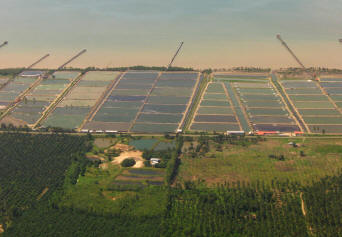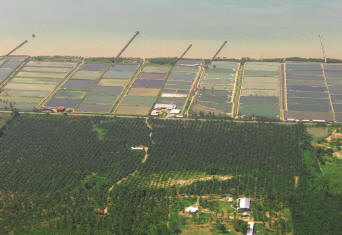




HOME > Photo Gallery > Tiger Prawn Farming in Tawau
Tiger Prawn Farming in Tawau
Starting 2009 all aquaculture farm operators in Sabah will be licensed in
stages to ensure the industry was better managed, established and dynamic and
continued to contribute to the economic development of the State.
All operators who had a breeding area of more than 0.4ha must have a license in
line with the Inland Fisheries and Aquaculture Enactment 2003.
The European Union wants Malaysian products to meet requirements like being
clean and safe. The industry had to be managed and controlled to always meet
international standards.
The mangrove forest along Batu Payung has been developed for aquaculture
activities. Aquaculture farms at Batu Payung is the biggest in Sabah, it is
still expanding.
Sabah has now 7,000 freshwater aquaculture farmers and 2,635 brackish-water
farmers.
Prawn farming is a main commercial activities in Tawau. Spawners from Tawau are graded the best in Malaysia. For decades, Tawau has been exporting high-grade tiger prawns to several countries such as Korea, Japan, Taiwan, China, Vietnam, Singapore, Egypt and Australia.
Tiger prawns are cultivated in brackish water ponds. The tiger prawn, Penaeus
Monodon, is the main species farmed in Tawau.
Sabah is the largest tiger prawn producer in Malaysia. Prawn farming is carried
out mostly in Tawau, Sandakan, Kota Kinabalu, Tuaran and Kota Belud.
Since time immemorial, people in Tawau have relied on the sea for their
sustenance. A great variety of high-grade fishes and all kinds of crustaceans
were found in abundance in the sea and waterways around Tawau. To the early
settlers, nearly all seafarers, making a living from the sea was easy. And in
the age of subsistence economy with a small population, in-shore fishing using
sampans was the norm. There was apparently no urgency or necessity to organize
the fishing folk to engage in commercial deep-sea fishing. However the Chartered
Company soon realized the potential of developing deep-sea fishing as a means to
augment and diversify the existing economic base. Once again they turned to the
Japanese, at that time the most modern Asian country and an ally of Britain.
In 1917, a Japanese merchant marine captain Jiro Orita launched the Borneo
Fishing Company, which differs from the previous fishing efforts in at least two
ways. Firstly, it was a larger operation and secondly, it was geared to support
the export market. The company set up an office in Tawau. The fishes were caught
in the surrounding waters, taken to Pulau Si Amil, an island about 10 miles (16
km) southeast of Semporna, where they were processed and then, taken to the
company's warehouse in Tawau to await shipment. Orita imported his labour from
Japan and Taiwan. Orita's Ice Plant, developed mainly for the freezing of fish ,
also supplied ice to the town.
Today, prawn farming is one of the main activities in Tawau. Spawners from
Sabah, especially Tawau, are graded the best in Malaysia. For this reason, Tawau
has been supplying high-grade tiger prawns to neighbouring countries, such as
Singapore, Hong Kong, Taiwan and Japan for decades.
A few hundreds deep sea trawlers and tuckboats can be seen at Cowie Bay.
OTHER LOCATION OF TIGER PRAWN FARMING in Malaysia :
Tiger prawns production in Langkawi
Langkawi is one of the producers of high quality tiger prawns which are marketed
through a network of leading supermarkets in Kuala Lumpur. No chemicals are used
throughout the cultivation process of the prawns.
The island's tiger prawns also reach a commendable size with 35 to 40 prawns
making up one kilogramme.
To meet this growing demand, tiger prawns cultivator, Sumber Nadi Alam, a
subsidiary of bumiputera owned Marine Ventures Sdn Bhd (TMV) plans to open 20
more of the tiger prawns breeding farms. This would bring Sumber Nadi Alam's
total number of prawn breeding farms to 42 at the Bukit Malut breeding project
site, here.
RELATED TOPICS
| Photo Gallery |